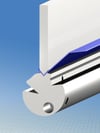Due to widespread use of sheet metal in different capacities, we see machinery like hydraulic brake presses put to use in a variety of applications. In this blog, we look at some of the different applications benders are used for in the HVAC industry.
When it comes to sheet metal bending, the HVAC industry has a broader installed base compared to other industries in terms of brake press usage, and it’s rare you’ll see a fabricator or duct shop without one. Generally speaking, brake presses are known for their versatility and flexibility of application, especially when outfitted with the appropriate tooling for a given job. Let’s run through some of the more common bender applications found in HVAC:
Rectangular Ducts and Box Vents
One of the more simple formations on this list, rectangular duct is bent using channel forming or box forming tooling, which are ideal for forming 90o angles with minimal difficulty. Additionally, cross-breaking should be used on straight ventilation to stiffen the walls and prevent the structural compromise that can often accompany temperature and air pressure changes.
Louvers and Sun Shades
Louvers, or ventilation slats, are required for most vent coverings and can require some more precise bends due to what is frequently a smaller surface area. To fabricate a louver, specialized “louver blade” upper dies are paired with the appropriate v-die. Although it depends on the overall vent design, louvers typically use heavier gauge sheet.
Damper Blades
Ducts requiring air flow compartmentalization and control (read: nearly every ventilation system) will rely on dampers to accomplish this. Designs vary, but most dampers are built with grooves in order to utilize a greater surface area and increase strength of the part. Most dampers also use slightly heavier gauge. Channel forming tooling is most often used in producing damper blades.
Fittings
As the name implies, fittings are used to get different part of straight ventilation to come together, like a joint. Elbows and tees are standard fitting examples. Because fittings often require overlap with the connecting duct, hemming is necessary when fabricating to facilitate the best fit during assembly.
Do you use a specific bending technique on your various HVAC components? Comment below and tell us about your project!






